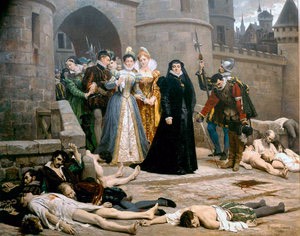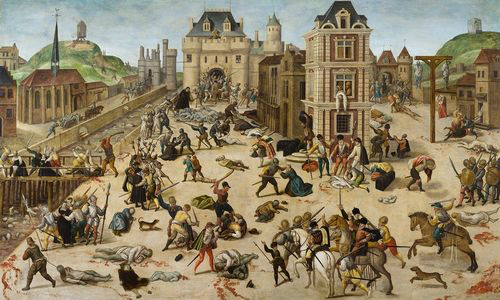
The Second Amendment, the right to keep and bear arms, is a controversial document.
For some Christians, faith and guns are antithetical concepts if not heretical. This is partly because of a pacifist tradition in Christianity which frowns on the notion of self-defense, but we are not discussing self-defense. Having the right to bear arms is different than bearing them.
Similarly, having the right to be a conscientious objector when it comes to homeschooling, abortion, and military service, is different than being a conscientious objector. What we must determine is whether the right to bear arms corresponds to our right of speech, press, and religion.
The connection between the right to bear arms and civil and religious liberties has been noted in the past. Jean Louis De Lolme, a political philosopher, who inspired the writers of the United States Constitution, opined that the right to bear arms acted as a surety for the other individual rights [1]. In the same vein Sir William Blackstone, legendary jurist who influenced generations of lawyers and even the writers of the US Constitution, wrote:
And lastly, to vindicate those rights, when actually violated or attacked, the subjects of England are entitled, in the first place, to the regular administration and free course of justice in the Courts of law; next, to the right of petitioning the King and Parliament for redress of grievances; and, lastly, to the right of having and using arms or self-preservation and defence [sic].²
Looking to the Bible we do not find a direct law or stipulation allowing for the right to keep and bear arms. However, we do see the ability of self-defense bearing a relationship to religious freedom.
As an example, we find the right to keep and bear arms being associated with religious freedom as found in the Book of Esther. Unlike the days of Prophets and Kings, Israel was no longer a unified nation living under their national laws and religious economy. The Jews were expatriates living in the Persian Empire. The Persian Empire was very tolerant of other religions including Judaism and thus Jews living in the Empire could enjoy a very reasonable degree of freedom to practice their faith.
However, because of hatred and anger, the prime minister of Persia crafted a law to cause the genocide of the Jews throughout the empire (Esther 3:1 - 6). The Prime minister’s anger toward the Jews was because they did not bow down to idols or to men who presumed to make themselves gods. The oppressive law was secured by bribery and corruption (3:8 - 11). This edict allowed anyone on a specific day throughout the entire Empire of Persia “to destroy, to kill, and to annihilate all the Jews, both young and old, little children and women, in one day … and to plunder their possessions” (3:13). Even more distressing than the decree itself is that once signed into law, it could not be revoked.
Fortunately, Queen Esther and her cousin Mordecai enabled the King of Persia to discern the plot and moved to stop it. For attempting such an odious deed the prime minister was executed. Since the law removing all civil protections from the Jews on a specific date could not be altered nor revoked, another piece of legislation had to be crafted to secure them. Ironically, to protect a defenseless population the solution was not an Empire-wide ban on swords, assault spears, or chariots. Instead, legislation was crafted allowing the Jews to arm and defend themselves from all who would come to kill or plunder. Granting the Jews the right to “to destroy, kill, and annihilate all the forces of any people or province that would assault them,” secured their religious freedom (Esther 8:13 NKJV)—even if these enemies were rogue actors of the state. Even though the most powerful personages of the state namely the king, queen, and new prime minister were against the genocide of the Jews, none of this could protect the Jews from destruction except the ability to defend themselves.
The Huguenots
Similarly, the first Religious Liberty Treaty in Europe, the Edict of Nantes, was enacted in 1598 allowing for the religious minority in France, the Protestants or “Huguenots” the right to bear arms to defend themselves even against the government [3]. Not only could they defend themselves with weapons but they were also given the right to have fortified cities, along with canon, and a cache of arms [4].
This was not done for hunting and sport but to serve as a guarantee for the liberties enshrined in the document. To understand why this treaty would go to such lengths to preserve liberty we must understand a little of the context in which it was conceived.
The edict was conceived in France after the bloody St. Bartholemew’s Day Massacre (1572), wherein the crown conspired with the Catholic Clergy to wipe out, in a single night, all the Protestants in Paris. Once the slaughter began in Paris it permeated throughout the nation. After about two months about 50,000 Huguenots were killed [5]. Finding no safety in the crown the Protestants fortified themselves in walled cities and armed themselves for battle.
To unite France and secure peace within her borders King Henry IV set out to pass an edict which would secure Freedom of Conscience for the religious minority Huguenots. Many liberal-minded Catholics supported this measure. Though this act would come up short to modern standards of religious freedom, it was very avant-garde for its time.

For example, the edict secured 200 towns of refuge for the rights of Protestants to be kept. It allowed Protestants in France to worship God according to their conscience in their homes, hold public worship in cities where Protestantism was established, publish their own literature, allow its members to hold office, educate their children, and granted state subsidy for its pastors [6]. Despite the success of Henry IV in securing the liberty of conscience for his people, his assassination by a fanatical monk in 1610 signaled the impending death of this edict.
If granting the King’s subjects liberty to defend themselves with arms even against the crown secured religious freedom, taking those arms away would mean its eventual end. The next king, Louis XIII, reigning as a child, was not disposed toward tolerating Protestantism in France. Indeed, his most trusted advisor, the politically shrewd Cardinal Richelieu, set out on a policy to make France an absolute monarchy. Unfortunately, the Edict of Nantes was an obstacle to his goal.
Summing up Cardinal Richelieu’s policy one historian mused: “He had two aims: first to make the will of the king supreme in France, second to make France the most powerful country in Europe. To bring about the first, he crushed the Huguenots, who then held considerable power; and broke down the pride and independence of the nobles” [7]. In order to “crush the Huguenots”, the estimated 200 towns or cities granted by the Edict of Nantes had to be destroyed. From 1621 to 1628 Cardinal Richelieu directed war against his own people to eliminate the independent towns/cities, disarm the Protestants, and nullify their political power [8]. The last city to fall was La Rochelle in 1628. This city was a place of refuge for Protestants all over France. It was the very place where their national synods were held and also acted as a safe haven during the various massacres and wars. According to the Edict of Nantes not only were the Huguenots free to practice their faith there but the walls of the city, along with its cannon, arms, and provisions served as an insurance policy to preserve those freedoms.
After a prolonged siege, La Rochelle fell. Of the estimated original population of 25,000 people, only 5,400 remained, most dying from starvation [9]. To maintain the theory of an absolute monarchy the King and the Prime Minister of France were willing to kill thousands upon thousands of their own Frenchmen to disarm and reduce all political independence from the crown. The justification for the state to act against its own people was because they feared “France would never be safe and enjoy peace, until this community was prostrated and deprived of its fortifications, castles, strong towns, and high privileges” [10].
According to Mosheim, after the destruction of La Rochelle “the Reformed community in France was prostrate: and being deprived of its fortresses, could depend upon nothing but the king’s clemency and good pleasure” [11].
The Huguenots would soon learn just how much they could depend on the crown for their freedoms. Nevertheless, despite losing its fortified towns and arms, and being barred from holding state office—unless of course, they abjured their faith—the Huguenots enjoyed a few years of peace. However, persecution did not slumber for long.
Louis XIV, the next king, followed in his father’s footsteps. Although the edict was not revoked each of the freedoms granted therein were stripped away. Louis XIV was not desirous of shedding the blood of his own countrymen for the sake of religious zeal. He wanted to convert all of France to a single faith—Catholicism—by enticements or misery. To entice Protestants he set aside state funds to pay new converts for rejoining the Catholic Church [12]. When this failed to have the desired effect, he turned the screws of misery upon the Huguenots.
Laws were quickly passed to suppress the rights of Protestants forbidding them to hold synods, to be employed on large estates, and to close their churches. They could no longer print books deemed offensive to papists and spies would sit in their services to inform the crown of any words uttered disparaging Catholicism [13]. Protestant ministers were exiled from France and if some returned or were suspected of holding services, a price was set on their head and a generous reward was given to informants [14]. The laws against Protestant families were particularly draconian. For example, the crown decided that children growing up in Protestants homes could be baptized as Catholics—against the will of their parents—and once baptized it was illegal for the child to revert to Protestantism [15]. Children born of any union between a Catholic and Protestant were declared illegitimate. In some instances the state, to “protect” Huguenot children from the religion of their parents, took them away and ordered the children be raised by their nearest Catholic kin [16]. Protestant children hoping to attend the University were forbidden. Worse of all when Huguenot families sent their children away to be raised by their Protestant kin in other countries the government made it illegal for Protestant children to leave the country, penalizing the offenders with service in the French galleys [17]. Keep in mind all of this took place while the Edict of Nantes stood on the law books!
The worst was yet to come. Louis XIV decided that his evangelistic efforts heretofore were not enough so he enlisted the aid of the military. Calling them his “missionaries,” Louis forced Protestant families to quarter his soldiers. Known as the "dragonnade", by those forced to endure it, it may have been a reason for founding fathers of the United States to add the Third Amendment to the Bill of Rights protecting citizens from quartering troops. Describing the operation of the dragonnade historian William Gammel writes:
Chosen squadrons of these terrible troopers lighted like filthy birds of prey on the homes of the Huguenots alike in cities and provinces wherever they are found. They carried with them the whole machinery of agony and despair—insult, outrage, degradation, the destruction of estates, the wanton violation of every sanctity, the inhuman practice of every atrocity, save murder alone. It was probably the most appalling form of wholesale persecution ever visited upon a civilized people [18].
Unable to defend themselves and unable to flee, many poor souls went insane, committed suicide, or abjured their faith. So terrible was the reputation of the dragonnade that whole towns of Protestants would convert to Catholicism at its approach. Though the borders were guarded to prevent escape many enterprising Huguenot families found ways of egress and it is estimated that over fifty thousand Protestant families left France to seek freedom of conscience in other countries [19].
Finally, after four years of initiating the quartering of troops upon a defenseless population the Edict of Nantes, which was essentially a dead letter, was officially revoked in 1685. Stripped of their arms and cities of defense the Huguenots were unable to exercise the rights granted to them in the Edict of Nantes, they could not protest, they could not participate in public policy, and could not worship God according to the dictates of the heart. The sad plight of the Huguenots should serve as a reminder of why all the rights of men should be sedulously guarded and not just the ones we think are important. The dangers of centralized power and arbitrary government are a threat to every individual freedom. Therefore, when Christians are tempted to turn their eyes away from the infringement of rights they deem unimportant, they ought to recall history and reconsider their ambivalence.

Timothy R Perenich MA, DC
[1] Jean Louis De Lolme, The Constitution of England; Or, an Account of the English Government, edited and with an Introduction by David Lieberman (Indianapolis: Liberty Fund, 2007), 136.
[2] William Blackstone, Commentaries on the Laws of England, 1:140.
[3] Noel Gerson, The Edict of Nantes (New York; Grosset & Dunlap: 1969), 112.
[4] Ibid.
[5] LeRoy Edwin Froom, Prophetic Faith of Our Fathers (Washington DC; Review and Herald: 1948), II:480
[6] J.A Wylie, History of Protestantism (Illustrated), (London: Cassell, Petter, & Galpin, 1894) Vol 2 of 3; Book 17: 622.
[7] Edward Bulwer-Lytton, “Cardinal Richelieu and His Enemy,” edited by Eva March Tappan, in The World’s Story; A history of the world in story song and art, Vol. 5 of 14 (Boston and New York: Houghton Mifflin Company, 1914), 241.
[8] John Lawrence Von Mosheim, Institutes of Ecclesiastical History, Vol. III of III (New York: Robert Carter & Brothers, 1861), 395.
[9] Judith P Meyer,. "La Rochelle and the Failure of the French Reformation." The Sixteenth Century Journal 15.2 (1984): 169-83.
[10] Mosheim, Institutes of Ecclesiastical History, Vol. III, 395.
[11] Ibid.
[12] William Gammell, “The Huguenots and the Edit of Nantes,” The Rhode Island Historical Society (Providence, RI: Providence Press Company, 1886), 21.
[13] Wylie, History of Protestantism (Illustrated), (London: Cassell, Petter, & Galpin, 1894) Vol 3 of 3; Book 22: 328.
[14] Voltarie, “The Revocation of the Edict of Nantes,” edited by Esther Singleton in, The World’s Great Events: An Indexed History of the World from Earliest Times to the Present Day by Great Historians, Volume 5 from A.D. 1648 to A.D. 1776 (New York: P.F. Collier & Son, 1913), 1416.
[15] Gammell, “The Huguenots and the Edit of Nantes,” 21 - 22
[16] Voltarie, 1419 - 20.
[17] Gammell, 22.
[18] Gammell, 23.
[19] Voltarie, “The Revocation of the Edict of Nantes,” 1418.